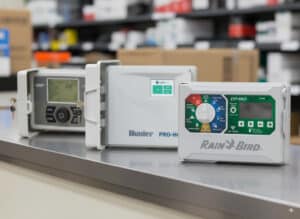
Product Description
Use the riser takeoff adaptor to connect a micro tube line to an existing riser. Simply screw off the existing spray head, screw on the adaptor with you new micro tube line and screw the spray back on.
These fittings are very handy and are ideal in situations where there are pots or planters near garden beds.
Riser Take Off Adaptor 15mm x 4mm
| SPECIAL Riser Take Off Adaptor 15mm x 4mm SKU: FLR-ADAPMICRO |
$4.18 $7.36 |
Product Description
Use the riser takeoff adaptor to connect a micro tube line to an existing riser. Simply screw off the existing spray head, screw on the adaptor with you new micro tube line and screw the spray back on.
These fittings are very handy and are ideal in situations where there are pots or planters near garden beds.





Product Specifications
| Riser Take Off Adaptor 15mm x 4mm | |
|---|---|
| Product Type | Adaptor |
| Product Material | Poly |
| Product Colour | Black, Teal |
| Product Unit Length | |
| Product Inlet Pipe Size | |
| Product Inlet Thread Size | 15mm BSPF |
| Product Outlet Pipe Size | 4mm Barb |
| Product Outlet Thread Size | 15mm BSPM |
| Product Max. Inlet Pressure (kPa) |
Customer Reviews
Handy Calculators
Not sure about Riser Take Off Adaptor 15mm x 4mm for your project? We’ve built these calculators to help you! (They’re actually awesome)

Micro Tools & Accessories, Risers & Fittings FAQs
Micro Drippers are perfect for pots, but your challenge is delivering the water to the pot. We suggest you run Poly Pipe as close as you can & then thin Micro Tube as hidden from view as possible up into the pot.
Due to the different flow rates or each type, it’s often not recommended. A micro spray will typically provide water at 1-2lpm, where as a fixed micro dripper will provide far less, at 2-8lph. However, there are adjustable drippers which can provide higher flows & there are applications where you may want less flow, like pots or native planting.
Each spray & dripper provides water at different rates, but the key factor is the flow rate of your water supply. Work that out with a simple timed bucket test. From there, you can work out how much water each sprinkler you’re looking at uses & work within your flow limit. For more information, check our Product Guides.
Because of their small outlets, micro sprays can block from time to time. Fixing individual sprays can be as simple as unscrewing them & simply blowing the blockage back out. To avoid repeat blockages we recommend installing a simple inline filter.
Yes, micro irrigation systems are designed for easy DIY installation. With a few basic tools and our guides, most homeowners and gardeners can set up a system tailored to their needs.
Yes, micro irrigation is perfect for hanging baskets and pots. Use adjustable drippers or micro sprays to provide precise amounts of water to each container, preventing over- or under-watering.
Small holes or cuts can be fixed with barbed joiners or goof plugs. For larger damage, cut out the affected section and rejoin the tubing with appropriate connectors.
You should consider using micro irrigation when you want precise, efficient watering for specific plants or garden areas, such as garden beds, vegetable patches, pots, hanging baskets, or landscaped zones. Micro irrigation is ideal for situations where water conservation is important, where you need to avoid wetting foliage, or when you want to minimise weed growth by delivering water only to the root zones. It’s especially beneficial for irregularly shaped gardens, densely planted areas, or locations with water restrictions. Micro irrigation is also a great choice for DIY gardeners seeking easy installation and customisation.
The best way to water your veggie patch is by using a drip irrigation or micro irrigation system. These methods deliver water directly to the root zones of your vegetables, ensuring consistent moisture while minimising water waste due to evaporation or runoff. Drip tube or micro drippers can be laid out along your rows or around each plant, providing targeted hydration that promotes healthy growth and reduces the risk of fungal diseases that can occur with overhead watering. For optimal results, use a tap timer or controller to automate watering, and consider adding a filter and pressure reducer to prevent clogs and ensure even water distribution.
Fully installed by a professional, a domestic irrigation system will come out to about $1000 per zone. And as a DIY project, it can look more like $300 per zone! But of course that’s a very rough estimate, each system is different and there are a lot of factors to consider. Thankfully, we have the only tool around that INSTANTLY give an accurate estimate for your. Try our INSTANT Irrigation Quote Tool here!
To choose the right irrigation system, consider the size and layout of your garden or lawn, the types of plants you’re watering and your water source. Spray systems are ideal for most applications like lawns and gardens, while drip irrigation works well for mulched garden beds and areas exposed to wind and evaporation. For expert advice tailored to your needs, request a quote from us. Or try our INSTANT Quote tool, which will give you some great recommendations!
To set up an irrigation system, start by planning the layout, then install the mainline pipes, valves and fittings. Attach the sprinklers, drip emitters or other irrigation devices, and connect the system to a controller. Finally, test and adjust the system to check for proper coverage and efficiency. For a more precise and tailored setup, visit our Design Department. Our experts can design and quote a customised irrigation system that perfectly fits your landscape.
At SunshowerOnline, we offer a wide range of irrigation systems perfect for home gardens, including spray irrigation, drip irrigation, pop-up sprinklers, micro irrigation. Just getting started? Our DIY kits make installation simple for beginners, while our expert team is available to help you design the ideal setup for your garden’s unique needs.
Our experienced Design Department can create a custom irrigation plan tailored to your property, whether you’re a homeowner, landscaper, or commercial manager. Simply provide your site details and requirements, and we’ll recommend the best products and layout for efficient, reliable watering. Need an instant quote? Try our INSTANT Quote tool!
Absolutely. We stock a comprehensive range of contractor-grade irrigation supplies, including control systems, valves, fittings, and commercial sprinklers, trusted by professionals across Australia. Bulk order discounts and trade support are available for our trade and commercial customers.
Yes, we offer step-by-step installation guides, video tutorials, and our service doesn’t stop once we a purchase is made. Expert advice over phone, chat or in-store is here to help! Whether you’re a DIY enthusiast or a professional installer, our resources make setting up your irrigation system straightforward and stress-free.
Yes, many of our irrigation products are designed for easy upgrades and retrofits. Whether you’re replacing old sprinklers, adding drip lines, or automating your watering schedule, our team can recommend compatible products and provide installation support.
To maximise the lifespan of your irrigation system, choose high-quality components, follow correct installation procedures, and perform regular maintenance such as flushing lines and checking for leaks. Our products are built to withstand Australian conditions, and our team is always here to offer ongoing support.
Yes, SunshowerOnline delivers irrigation supplies across Australia with fast, reliable shipping. Our customer service team is available to answer your questions, offer technical support, and ensure you find the right products for your project—no matter where you are located.
Whenever you’re connecting two threaded fittings, teflon is required. The only exception is whenever either fitting has an O-ring, in this case, do not apply teflon as it may cause the O-ring to not seal correctly. The amount of teflon you apply depends on the application. In any constant pressure applications you look at up to wrapping around the thread up to 20 times, whereas in any non-constant pressure applications, like on irrigation risers, 2 or 3 times around the thread is enough.
There’s no best type of sprinkler, just better sprinklers for different applications. Gear Drives are better for large areas, over 5m. Pop-Ups are ideal for 1.5-5m & Micro sprays are excellent for anything under that.
The type of nozzle all depends on how far you need to spray, each nozzle is specified by the radius it sprays & the spray arc it provides (0-360 degrees). Aim to spray to the base of the next closest sprinkler for even watering. For more information on planning, check out our Product Guides.
Each sprinkler & nozzle will push out water at different rates, but the key factor is the flow rate of your water supply. Work that out with a simple timed bucket test. From there, you can work out how much water each sprinkler you’re looking at uses & work within your flow limit. For more information, check our Product Guides.
As you install a system, it’s almost inevitable that small fragments of dirt will get into the pipe, for this reason you should always flush out the system before running it the first time. This can be done by leaving an open end at the farthest point of each irrigation zone & operating the zone for 15 or so seconds to flush it out. Then plug it up & you’re good to go! This can also be said for any other times dirt may have gotten into the system (eg: further irrigation repairs or a mains water supply fault).
We definitely don’t recommend it. Typically, drip tube will deliver the water at a far slower rate that sprays. Because of this, if you were to have both on the same zone, the areas with drip would be left far drier than the areas with sprinkler coverage. If you do want to water some areas with drip & some with sprinklers, it can be done, but each will just need to be run on their own separate irrigation zones.
Firstly, each sprinkler &/or nozzle has a specified spray radius. Secondly, sprinklers are typically designed to deliver more water at their base & progressively less the further away you get. For this reason, you want to position sprinklers so they spray to hit the base of the next sprinkler. Of course this isn’t possible all the time so in those cases, aim to spray at least 80% of the way. By doing this you will guarantee even water across your lawn or garden.
Even on a typical domestic system running on mains water a filter is still a good idea. In the event of a water main fault where rubbish does find it’s way down the line, a filter will protect the system from blockage and or failure. On systems operating off recycled water, like from a tank, a screen filter is mandatory. Debris like silt & dirt from recycled water is the most common cause of blockages of failures in irrigation systems.
Spray irrigation mimics natural rainfall by distributing water through a system of sprinklers and pipes. A pressurised water source – either mains supply, or from a pump – forces water through pipework and out of the water sprinkler nozzles, creating a spray that falls onto the landscape. This method efficiently delivers water to a wide area, ensuring even coverage and promoting healthy plant growth.
Spray irrigation systems, or sprinkler systems, distribute water through above-ground sprinklers, creating a wide spray pattern covering a larger area. This makes it efficient for watering lawns and large garden beds where uniform coverage is desired. However, this setup can lead to water loss through evaporation and wind drift, especially in hot or windy conditions.
Drip irrigation, on the other hand, delivers water directly to the plant roots through a grid of tubes with embedded emitters. This direct delivery approach is ideal for watering specific plants, rows of vegetables or areas with irregular shapes. By delivering water slowly and directly to the root zone, drip irrigation promotes deeper root growth and reduces weed germination. Please keep in mind that this system may not be suitable for large lawns, overly sandy areas or areas that require overhead watering.
Regular maintenance ensures your spray irrigation system operates efficiently and provides optimal watering for years to come. Start by periodically inspecting your system for leaks, clogged nozzles and damaged heads. Clear any debris obstructing the spray heads and adjust sprinkler heads to ensure proper coverage. It’s also important to flush your system occasionally to remove any sediment buildup. And although not typical for the Australian climate, some people may need to winterise their system in colder climates by draining the water to prevent pipes from freezing and cracking.
While many maintenance tasks can be performed by homeowners, consider scheduling professional maintenance at least once a year. A qualified technician can thoroughly inspect your system, identify potential problems and perform necessary repairs or adjustments to optimise performance and water efficiency.
You might also need...
Need more help with Micro Tools & Accessories, Risers & Fittings ? Check out these handy resources from our Help Centre














